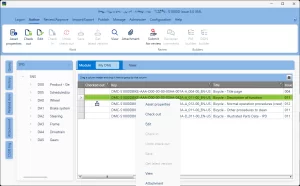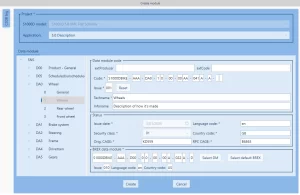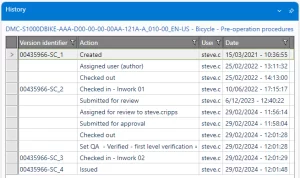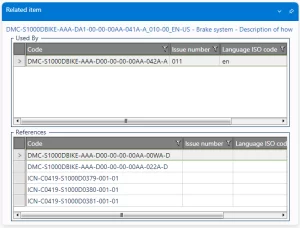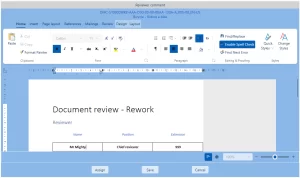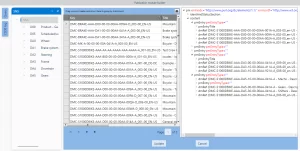notusCSDB – CSDB for S1000D authoring teams
notusCSDB is an all new way of providing a CSDB for S1000D authoring teams. It is fast, lightweight and simple to use. You can have your S1000D project up and running in less than a day. notusCSDB doesn’t lack key features, but we built it to be intuitive to use, and to provide just enough assistance when you need it. With its clean dashboard and clear division of functionality between user roles, your S1000D authoring team will thank you for choosing notusCSDB for your S1000D projects.
Light weight
notusCSDB gives managers and authors all the functions they need to manage S1000D projects. Easy workflow and monitoring is ideal for small teams. Don’t get bogged down in complicated processes
Fast
Get up and running quickly. Use our secure hosted solution and start straightaway. Alternatively, run a server yourself if you need your data kept on site. Import your project and you are ready to start authoring
Clear
We know CSDBs can be really complicated. We keep the screens clear with simple functions. Easily see the documents in your work-stream. Customise your dashboard for how you want to work
simple
notusCSDB is intuitive to use and easy to use means easy to learn. Everything you need is in one dashboard. Roles and groups mean allocation of work is easy. Administration is kept to a minimum
Everything you need from a S1000D CSDB
Built from the ground up to support S1000D authoring projects
S1000D CSDBs shouldn’t cost the earth!
We know producing data is expensive. Those costs can rapidly spiral if you have the wrong tools, or the tools you have make life difficult. The quicker you can get up and running on a new system, the less money is wasted.
We built notusCSDB to be:
~ quick and easy to install
~ quick and easy to learn
~ quick and easy to manage
By minimizing your adoption time and costs we maximize your return on investment. Integration with Contiem’s Eclipse range of S1000D authoring solutions can also speed up authoring and minimize errors, further enhancing your production.

Client testimonial
Here’s what one of our customers wrote about their new notusCSDB and recent training course
Getting started with a CSDB in S1000D
What is a Common Source Database?
A common source database, or CSDB is used to store the items that go to make up the project’s documentation data. So this may include data modules, illustrations or multimedia, common information and management information. S1000D does not define a CSDB in detail; instead, it defines the objectives for a CSDB:
~ support the technical publication process
~ support the controlled authoring
~ support the QA process
~ support the data exchange with partners, suppliers and customers
~ support the delivery of technical publications on various media independent from the source storage format
Why does my authoring team need a CSDB?
There are several reasons you may need a CSDB, but you also need to look at the type of CSDB. Start by thinking about your project:
Are you producing S1000D data modules for just one component, or for a whole product?
A product might be an aircraft, a ship, or any type of product that needs lots of complex documentation. We use S1000D to document our software products as it helps save us time when updating components. The bigger the project the more items that will need documenting. The more complex the documentation the more you will need a CSDB to manage the modules and version.
How many data modules do you need to produce and manage?
If it is just a few data modules and illustrations, you may get away with a folder in a file system. However, think about author control, version management, links between different modules and media content. All these add complexity to managing your data modules. A CSDB should help you both manage the content and the processes – for example authors checking in documents, a formal review system and history tracking. The CSDB will also help show the relationships between items – for example, an illustration used in multiple data modules; this tracking can save huge amounts of time and prevent costly mistakes, ensuring all related content is updated when a change is required in one of the linked items.
Does your prime manufacturer require you to use a CSDB for S1000D?
If you are producing S1000D data for someone else, for example when your component is installed in their product, they may require you to use a CSDB. There are added benefits to this – your project rules, numbering, and delivery can all be synchronised with the Prime, helping you deliver to specification first time round. Saving re-work saves money.
Will you have multiple authors or authoring teams working on the documentation?
One of the hardest things without a management tool, is monitoring workflow. Who is working on each data module? Who has spare capacity? Who has done the review and Quality Assurance work? Are your data modules (and all their linked content) ready to issue / deliver?
Can you show the history and validity of your data?
Sadly sometimes things go wrong and one of the costliest items in the production of modern equipment can be re-working mistakes and correcting badly specified material. The CSDB provides you with multiple tools to help prevent errors and mitigate problems: detailed history shows who changed what content, who approved it, and who issued it, ensuring duly qualified and authorised team members complete the work. Additionally, the management of attachments with work instructions, engineering certificates and such like, shows that any necessary governance steps have been completed. Finally, at the point of issue, you can ensure only correctly verified and issued data goes into your technical publications.
Why do I need Contiem?
Industry experience
Contiem’s aerospace and defence team have worked with several CSDBs over the years, supporting customers to manage their S1000D content in an efficient way. Many of these CSDBs are very sophisticated and capable, but that brings complexity and a high price tag. Having spoken to many component manufacturers, where often smaller teams are managing the authoring process, we have identified the need for a lower cost, easy to deploy CSDB to end the struggle to justify the large budget and complexity of other systems.
A solution that fits the problem
In response to this need we have developed notusCSDB using a tried and tested CMS platform. This light weight system has all the functionality needed to manage your S1000D content but without the high price tag and complex setup found with the larger systems on the market. We did not want to produce yet another complicated, high-end S1000D CSDB just because we could. For us, it is always about solving real life problems. All this is backed by the high standard of support provided by Contiem’s in-house support team.
notusCSDB for S1000D – key features:
notusCSDB support every version of S1000D from 1.6 to 5.0, in both XML and SGML formats. Each project is assigned a primary version, which drives which data module types, codification and BREX rules are available for the creation of new assets. However, a project can contain any DM from any version of S1000D. This can be particularly helpful with migration or upgrade projects.
Completely separate silos with their own user accounts for isolating test or training files from production files or for content that requires separation on the grounds of security, e.g. ITAR.
All projects within a silo can be accessed by all users that have access to that silo, allowing for flexibility when assigning users to projects and teams.
Share common assets between projects to prevent keeping multiple copies of the same data. Really useful for items such as:
Content can be loaded using a DML to specify the DMs to be added. Existing files and related media will be imported. Assets with no associated files will be created as metadata records for later populating in the CSDB (i.e. for creating new DMs required by the project DML).
Import and export is available from and to the file system and can include related items to simplify management. Select a publication module for export, and every data module and media item can automatically be exported together.
A Standard Numbering Scheme (SNS) is displayed so that the system breakdown can be used as a reference and a filter for DM listings and for creating new data module codes or illustration control numbers.
Several SNS tools are provided: import SNS from a BREX Data Module that contains SNS rules or from a local XML file, automatically create SNS structure from the content’s data module codes, or manually edit, add and delete SNS entries.
Customisable roles and groups provide many options for the control of workflow, allocation of sensitive tasks, and monitoring of progress. A manager can assign assets (data modules and illustrations) for editing to specific individuals or to groups. Users’ primary dashboards show only work they need to complete. When assigning work to a group, anyone in that pool can pick up the item to work on as soon as they are free. Much of the workflow assignment, eg review allocation and re-work return, is automatic.
notusCSDB automatically manages issue and in-work version control. As you check out items, local working copies are created and maintained until check in. In-work numbers update automatically on subsequent check out/check in. The manager can over-ride a check out if necessary to re-assign work to different team members. All previous issues are maintained in the CSDB, and rollback is available to an earlier version.
notusCSDB works seamlessly with Mekon’s Eclipse S1000D authoring tools in both Adobe FrameMaker and PTC Arbortext. You can look up and insert data module references, ICNs, common information and applicability all from your project files in notusCSDB without leaving the authoring tool.
The S1000D authoring tools include a built-in visual Publication Module builder. This is incredibly useful when you can simply drag and drop DMs from the asset grid onto the publication structure. The latest S1000D options including the pmEntryType attribute are supported. The PM can then be used to support the export and build of your publication, whether in a traditional book-build or PDF style manual, or into an electronic style IETP / IETM.
Similar to the Publication Module builder, the Data Dispatch Note builder also provide drag and drop of DMs from the asset grid onto the DDN structure. The export options for the DDN allow you to export a draft version, or ‘issue’ the DDN for a final delivery. The issued version can be exported again, but will always contain the same contents as at the point of issue.
notusCSDB has a built-in web viewer for displaying data modules and ICNs and automatic PDF creation for single data module preview. DMs are rendered in html for a fast view of the content without the need to export or open an external viewer. The viewer can also display most media types, including host-spotted CGMs. The PDF preview is fully formatted to the S1000D guidelines and is suitable for exporting to external reviewers, archiving copies, etc.
A simplified QA process allows for two stages of review as defined in S1000D. The reviewer adds comments on either a blank form or review templates using an internal wysiwyg editor. The CSDB stores the form with the DM or ICN. These comments are then available to the author when re-working the content. Form templates can be project-specific or database-wide for all projects.
To aid the review process, notusCSDB can also generate a review PDF, ready for marking up with the reviewers comments, and which is automatically attached to the DM on completion.
When ready for approval, an authoriser can then assign S1000D’s verification states and issue the asset.
Attachments can also be added to, and stored with any asset. This allows for the uploading of work instructions, external review certificates, and many other purposes.
notusCSDB tracks references to and from any given asset, which are displayed on the dashboard. This makes it incredibly simple to confirm links, update related content and manage the effects of any change.
Governance of data can be crucial in the lifecycle of a product. Ensuring that properly qualified and authorised persons have worked on and reviewed the content is critical. As well as making it easy to manage review and setting of verification levels for the data modules, notusCSDB also keeps a history of who by and when every critical action was taken in the lifecycle, for both DMs and ICNs.
notusCSDB brings S1000D and manageability together.
Without the cost!
If you would like a demonstration, or a free trial of notusCSDB, hit the button and fill in our short contact form. We will be in touch to see how we can help.
Screenshot gallery
Click each image to zoom in
- Dashboard author panel
- Create new module
- History tracking
- Related item tracking
- Built in reviewer commenting
- Extensive user management
- Publication module visual builder
- Export modules


